Credit Figured for You
If you choose to have the Internal Revenue Service (IRS) figure the credit for you, read the following discussion for the form you will file (Form
1040 or 1040A). If you want the IRS to figure your tax, see chapter 31.
Form 1040.
If you want the IRS to figure your credit, see Form 1040 Line Entries under Tax Figured by IRS in chapter 31.
Form 1040A.
If you want the IRS to figure your credit, see Form 1040A Line Entries under Tax Figured by IRS in chapter 31.
Examples
The following examples illustrate the credit for the elderly or the disabled. The initial amounts are taken from Table 34-1, shown
earlier.
Example 1.
James Davis is 58 years old, single, and files Form 1040A. In 1998 he retired on permanent and total disability, and he is still permanently and
totally disabled. He got the required physician's statement in 1998, and kept it with his records. His physician signed on line B of the statement.
This year James checks the box in Part II of Schedule 3. He does not need to get another statement for 2002.
He received the following income for the year:
| Nontaxable social security |
$1,500 |
| Interest (taxable) |
100 |
| Taxable disability pension |
11,400 |
James' adjusted gross income is $11,500 ($11,400 + $100). He figures the credit on Schedule 3 as follows:
| 1) |
|
Initial amount |
|
|
$5,000 |
| 2) |
|
Taxable disability pension |
|
|
11,400 |
| 3) |
|
Smaller of (1) or (2) |
|
|
5,000 |
| 4) |
|
Subtract the total of: |
|
|
|
| |
|
a) Nontaxable disability benefits (social security) |
$1,500 |
|
|
| |
|
b) Excess adjusted gross income [($11,500 - $7,500) ÷ 2] |
2,000 |
|
3,500 |
| 5) |
|
Balance (Not less than 0) |
|
|
1,500 |
| 6) |
|
Multiply line 5 × 15) |
|
|
225 |
| 7) |
|
Enter the amount from Form 1040A, line 28. |
|
|
383 |
| 8) |
|
Enter any amounts from Form 1040A, line 29. |
|
|
0 |
| 9) |
|
Subtract line 8 from line 7 |
|
|
383 |
| 10) |
|
Credit (Enter the smaller of line 6 or line 9) |
|
|
$225 |
His credit is $225. He enters $225 on line 30 of Form 1040A. The Schedule 3 for James Davis is not shown.
Example 2.
William White is 53. His wife Helen is 49. William had a stroke 3 years ago and retired on permanent and total disability. He is still permanently
and totally disabled because of the stroke. In November of last year, Helen was injured in an accident at work and retired on permanent and total
disability.
William received nontaxable social security disability benefits of $3,000 during the year and a taxable disability pension of $6,000. Helen earned
$9,200 from her job and received a taxable disability pension of $1,000. Their joint return on Form 1040 shows adjusted gross income of $16,200
($6,000 + $9,200 + $1,000).
Helen got her doctor to complete the physician's statement in the instructions for Schedule R. Helen is not required to include the statement with
her return, but she must keep it for her records.
William got a physician's statement for the year he had the stroke. His doctor had signed on line B of that physician's statement to certify that
William was permanently and totally disabled. William has kept the physicians's statement with his records. He checks the box in Part II of Schedule R
and writes his first name in the space above line 2.
William and Helen use Schedule R to figure their $135 credit for the elderly or the disabled. They attach Schedule R to their joint return and
enter $135 on line 47 of Form 1040. See their filled-in Schedule R and Helen's filled-in physician's statement on the next three pages.
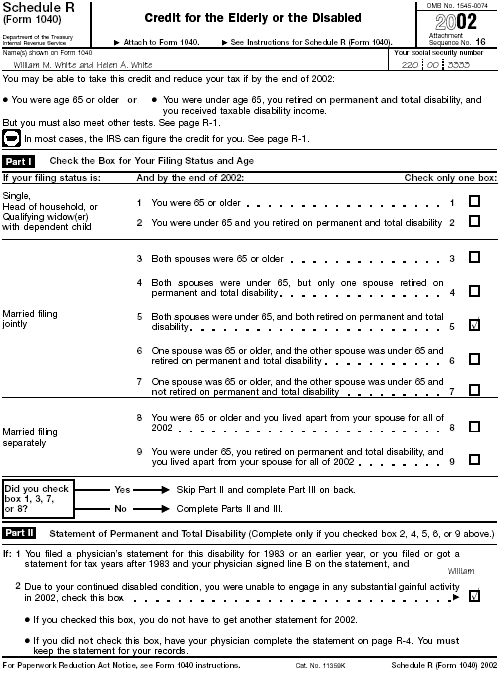
Schedule R, Pg 1 Schedules (Form 1040): R
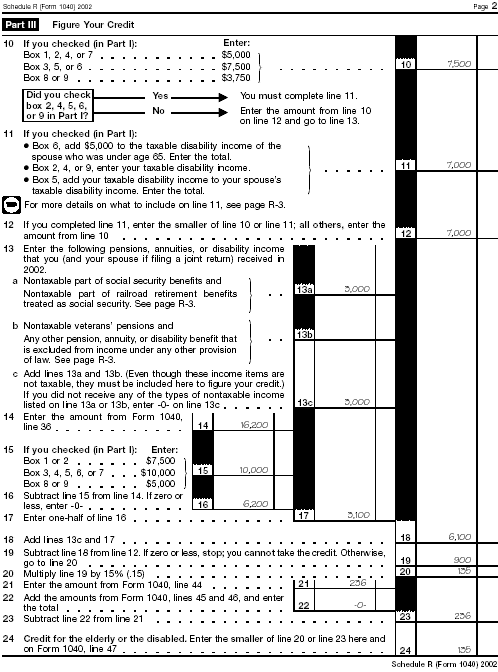
Schedule R, Pg 2
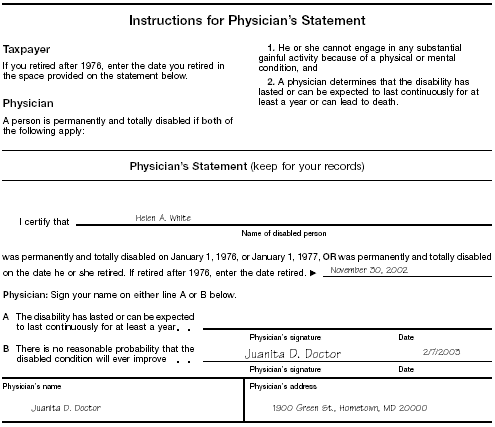
Helen's physician's statement
Child Tax Credit
Introduction
The child tax credit is a credit that you may be able to take on your tax return. It may reduce your tax by as much as $600 for each of
your qualifying children.
The additional child tax credit is a credit you may be able to take if you are not able to claim the full amount of the child tax
credit.
This chapter explains:
- Who is a qualifying child.
- How much is the credit.
- How to claim the credit.
- Why you should check your tax withholding.
The child tax credit and the additional child tax credit should not be confused with the child and dependent care credit discussed in
chapter 33.
If you have no tax.
Credits, such as the child tax credit, the adoption credit, or the credit for child and dependent care expenses, are used to reduce tax. If your
tax on line 44 (Form 1040) or line 28 (Form 1040A) is zero, do not figure the child tax credit because there is no tax to reduce. However, you may
qualify for the additional child tax credit on line 66 (Form 1040) or line 42 (Form 1040A).
Useful Items You may want to see:
Form (and Instructions)
- 8812
Additional Child Tax Credit
- W-4
Employee's Withholding Allowance Certificate
Qualifying Child
A qualifying child for purposes of the child tax credit must be all of the following.
- Under age 17 at the end of 2002.
- A citizen or resident of the United States.
- Claimed as your dependent.
- Your:
- Son, daughter, stepson, or stepdaughter,
- Brother, sister, stepbrother, or stepsister (or his or her child or grandchild) if you care for the individual as you would your own
child,
- Adopted child,
- Grandchild, or
- Eligible foster child.
Example.
Your son turned 17 on December 30, 2002. He is a citizen of the United States and you claimed him as a dependent on your return. He is
not a qualifying child for the child tax credit because he was not under age 17 at the end of 2002.
Adopted child.
A child placed with you by an authorized placement agency for legal adoption is an adopted child even if the adoption is not final.
Grandchild.
A grandchild is any descendant of your son, daughter, stepson, stepdaughter, or adopted child and includes your great-grandchild,
great-great-grandchild, etc.
Eligible foster child.
For the child tax credit, a person is your eligible foster child if both of the following are true.
- The child is placed with you by an authorized placement agency.
- You cared for that child as you would your own child.
In addition, the child must have lived with you for all of 2002. A child who was born or died in 2002 is considered to have lived with you for
all of 2002 if your home was the child's home for the entire time he or she was alive.
Kidnapped child.
A kidnapped child is treated as a qualifying child for the child tax credit if both of the following statements are true.
- The child is presumed by law enforcement authorities to have been kidnapped by someone who is not a member of your family or the child's
family.
- The child qualified as your dependent for the part of the year before the kidnapping.
This treatment applies for all years until the child is returned. However, the last year this treatment can apply is the earlier of:
- The year there is a determination that the child is dead, or
- The year the child would have reached age 16.
Amount of Credit
The maximum credit you can claim is $600 for each qualifying child.
Limits on the Credit
You must reduce your child tax credit if either (1) or (2) applies.
- The amount on line 44 (Form 1040) or line 28 (Form 1040A) is less than the credit. If this amount is zero, you cannot take this credit
because there is no tax to reduce. But you may be able to take the additional child tax credit. See Additional Child Tax Credit,
later.
- Your modified adjusted gross income (AGI) is above the amount shown below for your filing status.
- Married filing jointly - $110,000.
- Single, head of household, or qualifying widow(er) - $75,000.
- Married filing separately - $55,000.
Modified AGI.
For purposes of the child tax credit, your modified AGI is your AGI plus the following amounts that may apply to you.
- Any amount excluded from income because of the exclusion of income from
Puerto Rico.
- Any amount on line 43 or line 48 of Form 2555, Foreign Earned Income.
- Any amount on line 18 of Form 2555-EZ, Foreign Earned Income Exclusion.
- Any amount on line 15 of Form 4563, Exclusion of Income for Bona Fide Residents of American Samoa.
If you do not have any of the above, modified AGI is the AGI amount on line 36 (Form 1040) or line 21 (Form 1040A).
Claiming the Credit
To claim the child tax credit, you must file Form 1040 or Form 1040A. You must provide the name and identification number (usually a social
security number) on your tax return for each qualifying child.
Answer the Questions in your form instructions for line 50 (Form 1040) or line 33 (Form 1040A) to find out which child tax credit
worksheet you can use to figure the credit.
If you answer Yes to question 1, 2, or 3 in your Form 1040 instructions or question 1 or 2 in your Form 1040A instructions, you must
complete the child tax credit worksheet in Publication 972, Child Tax Credit. Otherwise, you can use the Child Tax Credit
Worksheet in your Form 1040 or Form 1040A instructions. (See the filled-in example, later.)
Example
Amy Brown files as head of household and has two dependent children under age 17. The children are qualifying children for purposes of the child
tax credit. Amy's only income is her salary of $23,500. Amy chooses to itemize her deductions and files Form 1040. Her AGI, shown on line 36 of her
Form 1040, is $23,500. This is her taxable earned income.
Amy does not file Form 2555, 2555-EZ, or 4563. She does not exclude income from Puerto Rico. Her modified AGI is $23,500.
Amy's tax, shown on line 44 of her Form 1040, is $763. She claims a $497 credit for child and dependent care expenses on line 46. She claims a
$2,033 earned income credit on line 64. She has no other credits.
After answering the Questions in the Form 1040 instructions for line 50, she completes the child tax credit worksheet to figure her
child tax credit of $266. Amy's completed questions and child tax credit worksheet are shown later.
Amy reads the TIP in the worksheet and finds that she may be able to take the additional child tax credit. See Additional Child Tax
Credit and Amy's completed Form 8812, later.
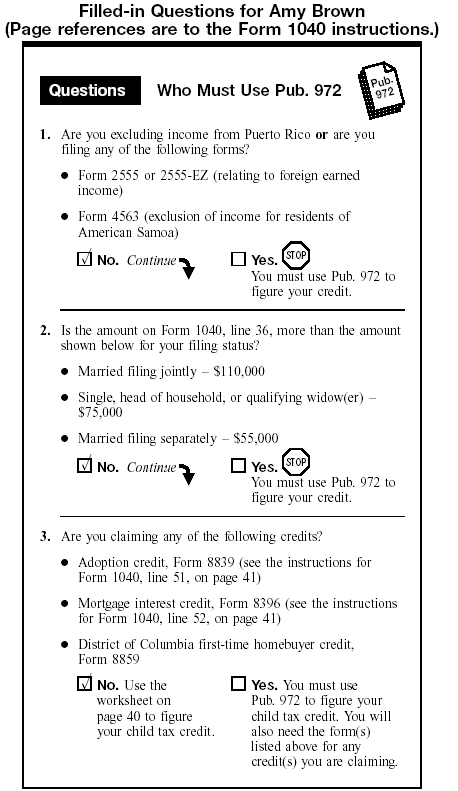
Filled-in Questions for Amy Brown
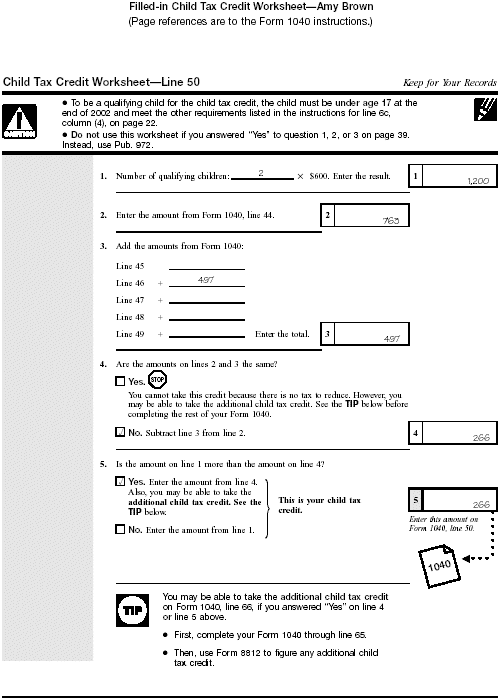
Filled-in child tax credit worksheet for Amy Brown
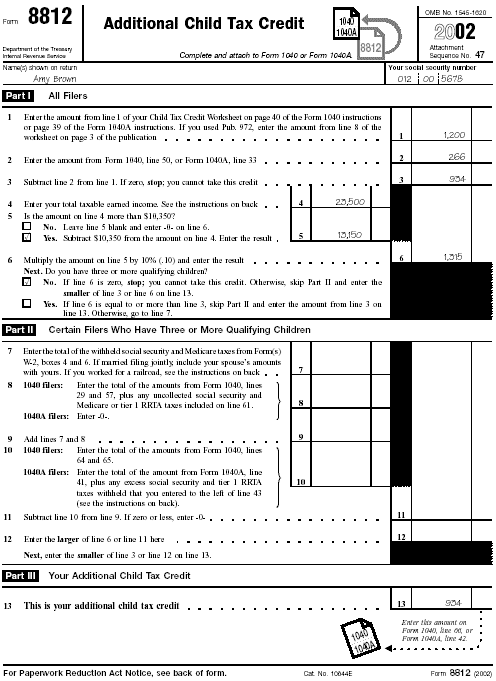
Filled-in Form 8812
Additional Child Tax Credit
This credit is for certain individuals who get less than the full amount of the child tax credit. The additional child tax credit may give you a
refund even if you do not owe any tax.
How to claim the additional child tax credit.
To claim the additional child tax credit, follow the steps below.
- Make sure you figured the amount, if any, of your child tax credit. See Claiming the Credit, earlier.
- If you answered Yes on line 4 or line 5 of the Child Tax Credit Worksheet, use Form 8812 to see if you can take the
additional child tax credit.
- If you have an additional child tax credit on line 13 of Form 8812, carry it to line 66 (Form 1040) or line 42 (Form 1040A).
Taxable earned income.
Generally, for purposes of the additional child tax credit, your taxable earned income is the amount on line 7 of Form 1040 or Form 1040A. See the
instructions for Form 8812 to figure your taxable earned income.
Checking Your Withholding
The child tax credit decreases your tax. You can check your tax withholding by using Publication 919, How Do I Adjust My Tax
Withholding.
If you are having too much tax withheld, and you prefer to have the money during the year, you may be able to decrease your withholding. You do
this by completing a new Form W-4 and giving it to your employer.
Education Credits
Important Changes for 2002
Education credit and distribution from Coverdell ESA or QTP.
Beginning in 2002, you may be able to claim an education credit in the same year in which you receive a distribution from a Coverdell education
savings account (ESA) or a qualified tuition program (QTP). However, you cannot use the same expenses to figure both the education credit and the
taxable portion of a Coverdell ESA or QTP distribution. See No Double Benefit Allowed under What Expenses Qualify, later.
Income limits for credit reduction increased.
For 2002, the amount of your education credit is gradually reduced (phased out) if your modified adjusted gross income (MAGI) is between $41,000
and $51,000 ($82,000 and $102,000 if you file a joint return). You cannot claim an education credit if your MAGI is $51,000 or more ($102,000 or more
if you file a joint return). The 2001 limits were $40,000 and $50,000 ($80,000 and $100,000 if filing a joint return). See Does the Amount of
Your Income Affect the Amount of Your Credit, later, for more information.
Previous| First | Next
Publication 17 | 2002 Tax Year Archives | Tax Help Archives | Home
